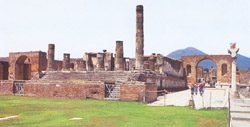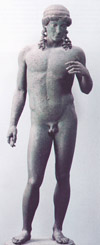
TEMPLE OF JUPITER - POMPEII

The name of the temple derives from its original function in the Samnite period. Following the town’s colonisation, the temple became a Capitolium, a temple dedicated to the capitoline triad of Jupiter, Juno and Minerva, in accordance with the religious tradition of Rome which required the centre of every town to have a temple dedicated to the most important gods on Mount Olympus. With its dominant position in the Forum and lofty Mount Vesuvius looming ominously behind it, the Temple of Jupiter is emblematic image of the destruction of Pompeii. The Temple stands on an Italic podium measuring about 17 metres along the front by 37 metres down the sides and has rows of steps running along the whole façade looking onto the Forum. At the top of the steps, six columns – originally about 12 metres height – led into an open space (the pronaos) which in turn led into the ‘cella’ or inner sanctuary. The cella was divided into three areas housing the statues of the capitoline triad. The temple had two narrow flights of stairs, one on either side of a large central dais where the altar stood, and two monumental balustrades with equestrian statues. A bas relief portraying the temple during the earthquake was found in the lararium in the house of Caecilius Jucundus and gives us a glimpse of what the building was really like. Under the podium was a series of small chambers where the temple’s sacred furnishings, votive offerings and perhaps also the Treasury were stored.





